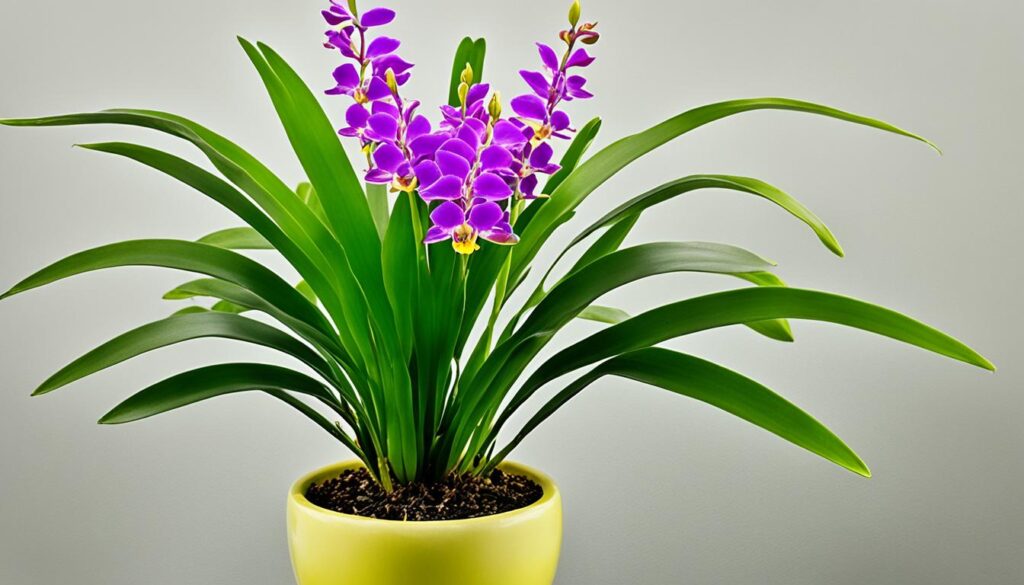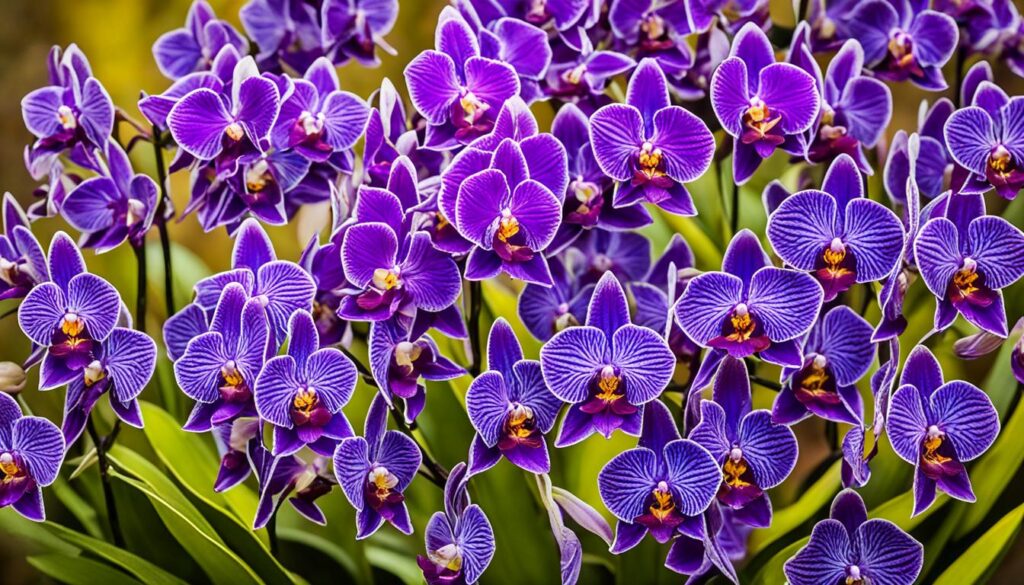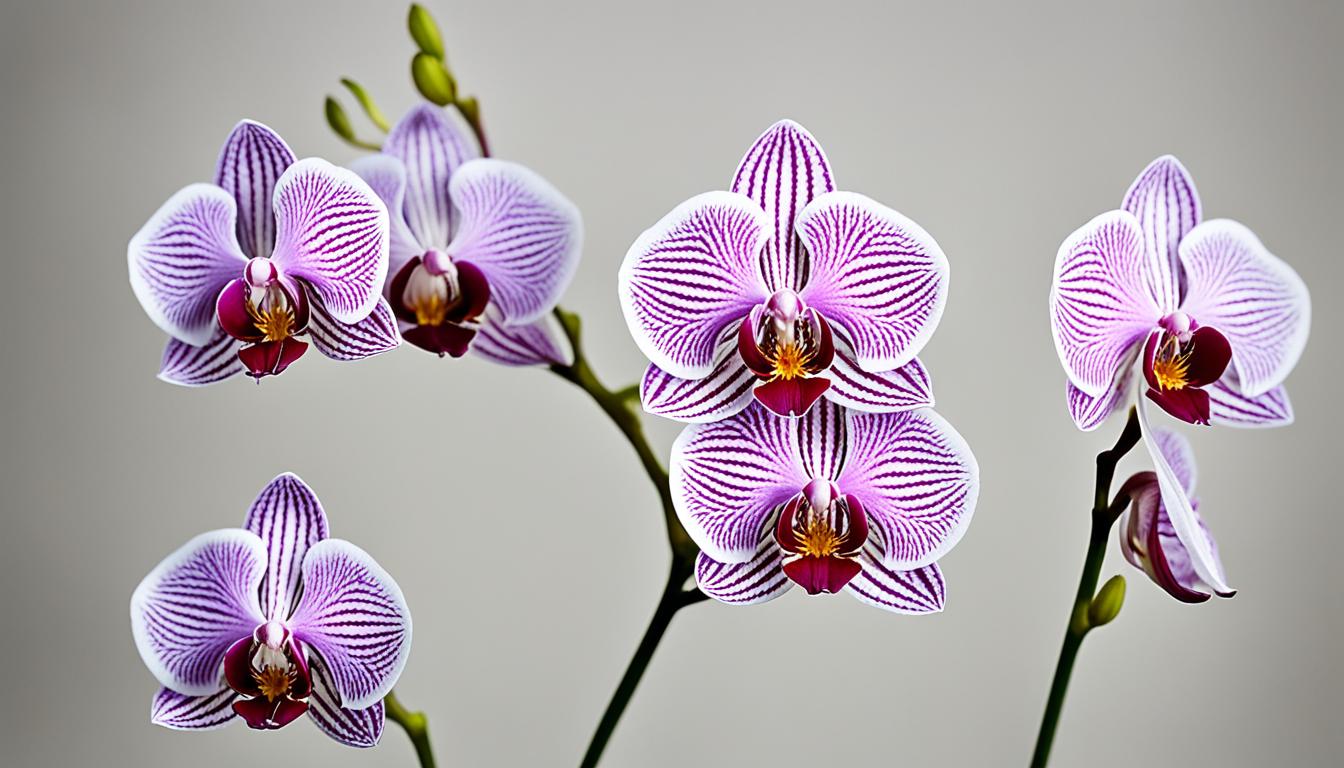Believe it or not, there are more than 25,000 species of orchids on our planet. Among them, Doritis orchids hold a special place with their understated elegance and ability to shine with vibrant blooms without the need for a grand stage.
Quick Facts
| Characteristic | Detail |
|---|---|
| Countries of Origin | Southeast Asia, including Thailand, Malaysia, Indonesia, and the Philippines |
| Colors | Various shades of white, pink, purple, and red |
| Size | Typically small to medium-sized, ranging from miniature to standard |
| Difficulty To Grow | Moderate difficulty; requires attention to specific cultural requirements |
| Bloom Season | Typically blooms in spring or early summer |
| Light Requirements | Bright, indirect light; avoid direct sunlight |
| Watering Needs | Keep moist but not soggy; water when the top inch of the potting medium feels dry |
| Temperature Range | Prefers warm temperatures, typically between 60-80°F (15-27°C) |
| Potting Medium | Well-draining orchid mix, such as bark or sphagnum moss |
| Propagation Methods | Division of pseudobulbs or keikis (baby plantlets) |
| Common Pests and Diseases | Pests: Aphids, scale insects, spider mites. Diseases: Root rot, fungal infections |
| Fragrance | Some varieties may have a light, sweet fragrance |
| Lifespan/Longevity | Can live for several decades with proper care |
| Conservation Status | Some species may be threatened due to habitat loss and over-collection |
| Unique Features | Many Doritis Orchids have attractive spotted or striped patterns on their petals; some species produce keikis on flowering stems for easy propagation |
I’ve discovered that beauty in simplicity is more than just a saying, it’s a living spectacle in the form of Doritis orchid varieties.
Their charm lies not in accolades from prestigious competitions, but in the tender care and watchful eyes of those who nurture them at home.
Spotting the right corner that offers the perfect amount of light could be the ticket to their thriving existence.
It’s like being an experienced gardener without years of trial and error, orchids seem to flourish when they feel loved and unrestricted in their diet.
Clean leaves, free of debris, allow Doritis orchids to breathe and showcase their beauty unabashedly.
Engaging with a community of orchid lovers, such as those at local orchid society gatherings, always opens up new chapters of understanding and joy in cultivating these enthralling plants.
Key Takeaways
- There’s a surprising variety of over 25,000 orchid species worldwide.
- Doritis orchids exemplify understated elegance with their vibrant blooms.
- With proper care and the right environment, these orchids are easy to please.
- Attention to detail, like appropriate lighting and feeding, ensures a flourishing plant.
- A clean orchid is a happy orchid — regular grooming can lead to a healthy, blooming Doritis.
- Joining local orchid societies can offer invaluable insights into better care for your Doritis orchids.
Introducing the Charming Doritis Orchids
As someone who has witnessed the charm of many flowers, I must say Doritis orchids hold a special place with their simplicity and vibrant allure.
In my hands-on experience, they serve as an introduction to the joy of orchid care, making them perfect for those just starting out but equally fascinating for seasoned growers.
Their vibrant doritis blooms bring a sense of accomplishment to any orchid lover’s collection.
Unveiling the Doritis Orchid’s Allure
The true allure of Doritis orchids lies in their capacity to sprout vibrant blooms with what seems like minimal effort.
They’ve been a mainstay in my growing space, continually brightening the room with colors that seem to encapsulate joy in petal form.
Their maintenance aligns with the beckoning simplicity in orchids, a trait that encourages growers at all skill levels to delve into caring for these charming varieties.
Following a straightforward doritis orchid care guide can result in a thriving floral display that captures the admiration of anyone who enters the room.
The robust nature of these orchids allows them to adapt to a range of conditions, and their enduring beauty is a testament to their resilience and grower-friendly nature.
Origins and Distinct Features of Doritis Species
Originating from diverse regions, each Doritis species tells a story of adaptation and uniqueness.
In my pursuit of distinct orchid varieties, I’ve discovered that understanding their origins is key to providing the specialized care they require.
These species come from environments that vary dramatically, which in turn shapes their size, color, and overall care needs.
- Doritis pulcherrima – Known for its broad, colorful petals, it’s a star in my greenhouse.
- Doritis buyssoniana – Its slender form and delicate flowers make it a subtle yet striking presence.
- Doritis crassifolia – I’ve found its sturdy leaves and dense floral spike to signify its resilience.
By exploring different Doritis species, their distinct characteristics unfold, guiding better care practices.
For instance, the amount of light a Doritis buyssoniana needs might differ from that of a Doritis pulcherrima.
It’s this granularity in understanding their distinct features that has led me to success in fostering more luscious, healthy blooms.
| Doritis Species | Light Requirements | Watering Frequency |
|---|---|---|
| Doritis pulcherrima | Bright, indirect light | Once a week |
| Doritis buyssoniana | Medium to bright light | Every 5-7 days |
| Doritis crassifolia | Low to medium light | Bi-weekly |
By adhering to these doritis growing tips, anyone can experience the enchantment of cultivating these unique plants.
The joy of watching vibrant doritis blooms unfold is truly one of the simpler pleasures in life, a journey well worth embarking on.
Nurturing Your Doritis: Essential Care Tips
As a dedicated plant parent, I’ve learned that fostering thriving Doritis plants requires a bit more than just your average run-through on how to keep a plant alive.
So buckle up, fellow orchid enthusiasts, because I’m about to unveil some orchid care instructions to turn your Doritis into the envy of the botanical community.
First things first, lighting is like the Instagram filter for your Doritis—it can make or break the aesthetic.
High-quality light brings out the best in the blooms, ensuring they’re vibrant and full of life.
But too much light? Might as well call it the fast track to Wilt Town.
The trick is a cozy spot that provides bright, indirect sunlight to mimic the dappled light of a forest floor, think near an east-facing window where it can soak in that morning sunshine.

Watering is where most of us get a bit antsy, too little and they’re reaching for the skies, too much and you’ve got yourself a soggy mess.
Here’s the deal: deep watering until water runs out the bottom of the pot every 5 to 7 days during the growing season, then cutting back in the winter.
And humidity? Doritis orchids aren’t in the desert for a reason.
They crave that tropical moisture in the air, so let’s keep it at a delightful 50-70%.
Now let’s chat about food because a flourishing Doritis is a well-fed one.
Fertilizer is their secret sauce, and a balanced 20-20-20 mix applied every other week will keep those leaves greener than a St. Patrick’s Day parade.
But remember, come winter, it’s time to ease up on the feast.
- Watering: Deep weekly sessions; less in winter
- Humidity: Maintain at 50-70%
- Feeding: Balanced fertilizer every other week; reduce in winter
- Lighting: Bright, indirect sunlight
Let’s sum it up with a handy table because who doesn’t love a quick reference?
| Care Aspect | Instructions | Reason |
|---|---|---|
| Watering | Once a week, less in winter | Simulates natural watering patterns, avoiding root rot |
| Humidity | Keep at 50-70% | Mimics tropical conditions, promoting health |
| Feeding | 20-20-20 fertilizer every other week, less in winter | Provides essential nutrients for growth |
| Light | Bright, indirect sunlight | Encourages vibrant blooms and strong growth |
By following these Doritis care steps, I can promise you’ll be well on your way to having one of the most thriving Doritis plants on the block.
It’s not rocket science, but it sure is rewarding when those spectacular blooms make their grand entrance.
Doritis Orchids Varieties: A Spectrum of Beauty
When I set out to expand my diverse orchid collection, the allure of Doritis orchid varieties beckoned irresistibly.
With every addition, the spectrum of beauty within my living space amplified, highlighting the rich color palettes of doritis.
It’s this vibrant variety that makes doritis orchids so popular among enthusiasts like me, each bloom adding a unique brushstroke to the floral canvas of our homes.

Every time I observe my collection, I’m struck by the orchid color variations, from deep purples to radiant pinks.
These living artworks don’t just sit there; they tell a story through their orchid blooming patterns, marking time and season with their rhythmic life cycles.
It’s no wonder that popular doritis orchids have a special place in the hearts of collectors, as they punctuate our daily lives with their recurring splendor.
Discovering the Popular Varieties of Doritis Orchids
It’s captivating to discover the different faces of this genus. Popular varieties like the Doritis ‘Pulcherrima’ have stolen my heart with their charming lavender blossoms.
It’s these bursts of colors that make every corner of my garden or living quarters come alive, changing the vibe with the natural ebb and flow of their lifecycle.
I love knowing that each variety I select has the potential to surprise me with its individual display.
Color Palettes and Blooming Patterns
The color palettes of doritis are something to behold. While some varieties offer a gentle echo of sunrise with tender coral hues, others exhibit the drama of sunset with bold, almost fiery petals.
The blooming patterns also play a huge part in my orchid care journey, teaching me to anticipate the peak seasons for each beloved variety in my collection.
Whether it’s the subtle shift of shades in ‘Buyssoniana’ or the striking color contrast in ‘Pulcherima Blue’, the patterns of blooming serve as nature’s own calendar within my orchid sanctuary.
Indeed, embracing these orchid blossoms, with all their color and variety, is akin to curating a living art exhibit.
My excitement never fades with each new bud’s swell, anticipating the unique addition to the ongoing showcase.
In the vibrant world of doritis orchid varieties, I find continuous joy, a testament to the endless possibilities they offer.
Conclusion
As I wrap up this journey through the world of Doritis orchids, it’s clear that these plants offer a rewarding experience for anyone with a love for growth and beauty.
I’ve seen firsthand how thriving doritis plants enhance spaces with their lively colors and patterns.
With easy-to-follow doritis care routines, even those new to orchids can watch these beauties flourish.
The secret to orchid growing success doesn’t lie in complex techniques; it’s all about sticking to simple, consistent care.
The allure of doritis orchids beauty is undeniable. Each variety presents a chance to add a unique twist to your garden or home.
Embracing the diversity of these plants means there’s always something new to learn and admire.
If you’re patient and attentive, you’ll find that these orchids aren’t just plants; they’re companions on a fascinating horticultural journey.
My hope is that your adventure with Doritis orchids is as fulfilling as mine has been. Remember, the true joy of growing these orchids isn’t just in the blooms you’ll eventually marvel at, but in the care and dedication you invest along the way.
Here’s to the successes, and even the little challenges, that make gardening with these splendid plants so enriching.


Leave a Reply